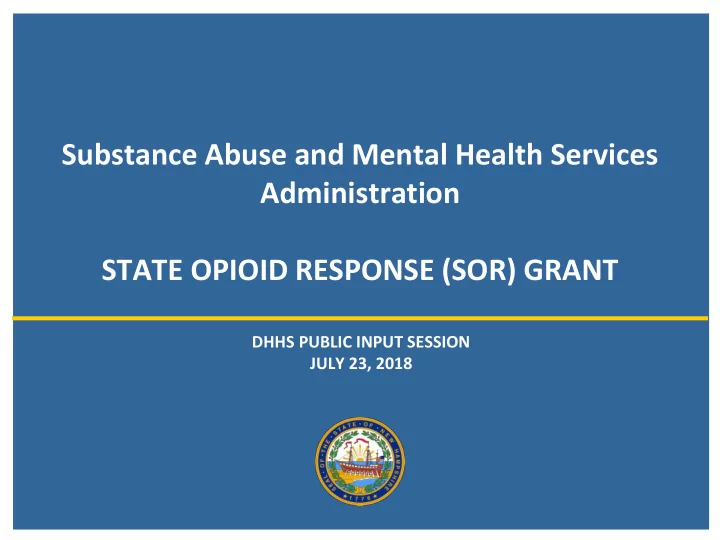

Substance Abuse and Mental Health Services Administration STATE OPIOID RESPONSE (SOR) GRANT DHHS PUBLIC INPUT SESSION JULY 23, 2018
Agenda 2 ► Grant opportunity overview and timeline ► Grant parameters ► Key data requirements ► Stakeholder comment ► Next Steps
Grant opportunity overview and timeline 3 • NH eligible for up to $45,794,694 for Federal Fiscal Year 18 and 19 • Two years to spend funds • State FY19:$22,897,347 • State FY20:$22,897,347 • Funding specific to opioid use disorder (OUD) • Funding goals: • increase access to medication-assisted treatment • reduce unmet treatment need • reduce opioid overdose related deaths June 14: SAMHSA Approx. Now-July 27: posts Funding August 13: September 30: December 2018: DHHS accepting Opportunity Application Due Notice of Award Services available public input Announcement
Grant overview cont. 4 • Require use of evidence based treatment for OUD (MAT), alignment with State Targeted Response grant strategic plan, services delivered by the third month after grant award • Key populations include: Veterans/service members, Ryan White HIV AIDS program, justice involved/re-entering the community • Of the $22,897,347 per year • Up to 2% may be spent on data collection • Up to 5% may be spent on administration of the grant Key staff required: • • Must include Project Director • Must include full-time State Opioid Coordinator position: responsible for coordinating opioid-related federal funding across the State
Funding Parameters 5 ALLOWANCES RESTRICTIONS MAT financing and support if FDA • Financial support for recovery housing • approved product is limited to “legitimate and Recovery support services, including • appropriate” facilities recovery housing. Telehealth limited to • Purchase/distribute/train on naloxone • rural/underserved areas Provide assistance to patients with • Cannot support non-evidence based • treatment costs. approaches Provide treatment transition and • Cannot pay for programs that deny • coverage for patients reentering service due to MAT status communities from criminal justice Cannot fund bricks and mortar • settings or other rehabilitative settings. Cannot pay for meals • Address barriers to receiving treatment Funds must be payer of last resort • • Telehealth • (exhaust insurance and other financing Tobacco cessation programs • options first) Can fund nonprofit or for-profit entities •
Data requirements 6 Minimum required data elements: (client-level) - Diagnoses - Demographics - Substance use - Services received - Criminal justice involvement - Housing status - Employment status Specific Data Collection Tools Mandatory performance measures Government Performance and Recipients must achieve 80% Results (GPRA) tool required: follow-up rate at: 1) Fact to Face interview 3 months • 2) Four data collection points 6 months • 1) Intake 2) 3 months post-intake 3) 6 months post-intake 4) Discharge SAMHSA will announce additional required data elements following award
Next Steps 8 • DHHS will continue accepting input until July 27, 2018 • July 23 session • Submit to SOR@dhhs.nh.gov • DHHS will vet input through funding allowances/restrictions • Will seek clarification on use of funds from SAMHSA if necessary • Submit final application to SAMHSA on/by August 13, 2018
Questions and Comments 7
Recommend
More recommend